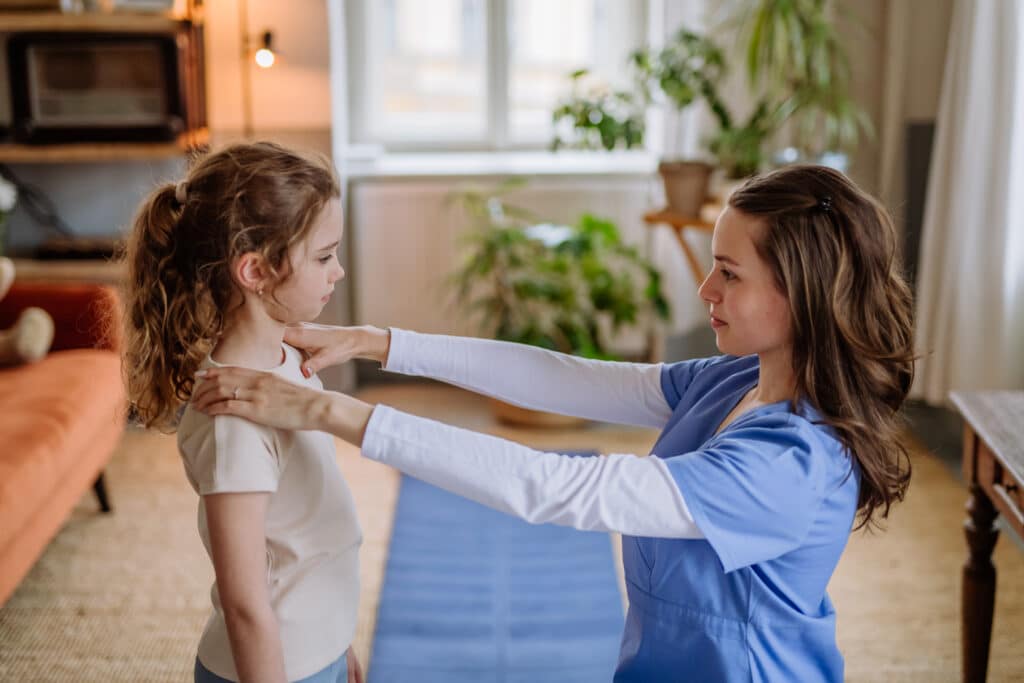Scoliosis, a condition characterized by an abnormal curvature of the spine, is particularly concerning when diagnosed in young children due to the potential for progression during growth spurts. For one family, a routine scoliosis X-ray for their six-year-old daughter, Lily, turned into a challenging journey marked by uncertainty and fear. However, through persistence and exploration of alternative treatments, they found hope and remarkable success with the Strauss Method, reducing Lily’s spinal curve from 34° to 9°. This article recounts their experience and the transformative impact of seeking a second opinion.
The Initial Diagnosis
Lily had just turned six in August 2021. During a routine physical, her pediatrician conducted a scoliosis check—a precaution initially intended for her older sister. The pediatrician immediately noticed an abnormal curvature in Lily’s spine and advised the family to consult a specialist. This unexpected discovery set the family on a path they never anticipated, especially since Lily’s mother had also dealt with scoliosis, a factor that had not initially raised concern for their children’s health.
Consultation with the Specialist
The family visited an orthopedic specialist in New York City, where a comprehensive evaluation quickly followed. The specialist confirmed that Lily had a 34° curvature in her spine. The recommendation was swift and stern: Lily needed to wear a brace for 21 hours a day to manage the condition, with the looming possibility of surgery if her condition worsened. For Lily’s mother, memories of her own uncomfortable brace and the emotional toll of scoliosis resurfaced, making the prospect of her young daughter enduring the same challenges particularly distressing.
Searching for Alternatives
Unsatisfied with the initial consultation and the limited options presented, Lily’s father, a journalist by profession, began researching alternative treatments. His search led him to the Strauss Method, developed by Dr. Strauss, which offered a different approach to managing scoliosis. Encouraged by the testimonials and the detailed information available, he decided to explore this option further.
The Strauss Method
The Strauss Method focuses on non-surgical, non-bracing interventions that involve specific exercises designed to strengthen the muscles supporting the spine and improve posture. Dr. Strauss reviewed Lily’s scans and provided a detailed plan, offering hope and a new perspective on managing her scoliosis. The family felt an immediate sense of relief and optimism, a stark contrast to their initial discouragement.
Treatment and Progress
Lily began the Strauss Method regimen, which included targeted exercises tailored to her condition. The family noticed improvements in her mobility and posture even before the first follow-up scan. Over time, the results were nothing short of remarkable.
Lily’s spinal curvature decreased progressively with each subsequent x-ray: from 34° to 23°, then to 18°, slightly back to 19°, down to 14°, and eventually under 10°, with the latest measurement at 9.95°. Each milestone reinforced their belief in the efficacy of the Strauss Method.
Specialist’s Reaction and Ongoing Care
The orthopedic surgeon who initially diagnosed Lily continued to monitor her progress through regular x-rays. The dramatic improvement in Lily’s condition was met with surprise and acknowledgment of the rarity of such outcomes without surgical intervention. This reinforced the importance of exploring and validating alternative treatments.
Advocacy for a Second Opinion
Lily’s story highlights a critical message for parents and individuals dealing with scoliosis: the importance of seeking multiple opinions and exploring all available options. The initial recommendation for bracing and potential surgery felt like a narrow and daunting path. However, the family’s determination to find a less invasive solution led them to the Strauss Method, which proved to be life-changing.
Scoliosis X-ray in 6 Year Old: 34° Curve Reduced to 9° with Strauss Method
Lily’s journey from a 34° spinal curve to just under 10° showcases the transformative potential of the Strauss Method for managing scoliosis. This case underscores the necessity of comprehensive research and consultation in medical treatment, especially for conditions as impactful as scoliosis. The family’s experience serves as a powerful reminder that while traditional methods may dominate initial consultations, alternative treatments can offer significant and lasting benefits. For those facing a similar diagnosis, Lily’s story is a beacon of hope, advocating for informed decision-making and persistence in seeking the best possible care.
Also read: Degenerative Scoliosis Can Be Successfully Treated!


